Colony Management – Caring for Your Colony
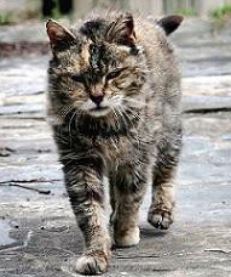
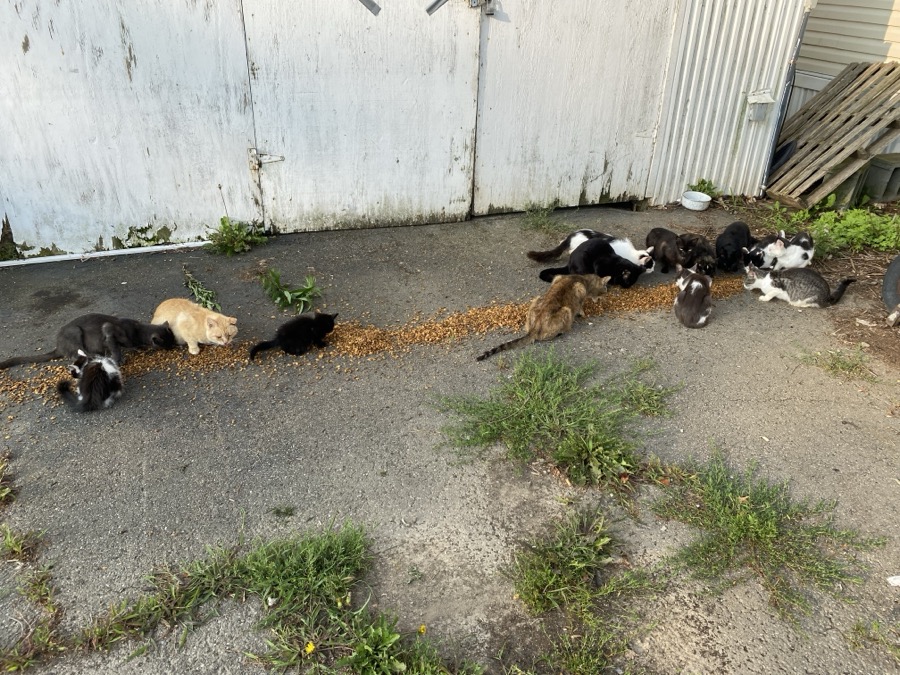
If you cannot commit to proper care and long-term management, do not put food out for any cat. Once you put food out you become a “colony manager” and the cats become dependent on you.
The following guidelines and suggestions will help you provide proper care to your feral cat colony.
Scroll down the page or click on a topic for links to helpful information from feral cat experts.
GENERAL INFORMATION
Use the Trap, Neuter, Vaccinate and Return (TNRV) method. This provides humane care while gradually reducing the number of cats in a feral cat colony.
Never care for a colony of cats on property you do not own or do not have permission to be on in (this should be in writing). The cats will depend on you and you might be forced to stop caring for them.
Keep a record for each cat. Keeping track of colony members, their health, new cats that have joined the colony that may need to be neutered, and your ongoing Trap- Neuter-Vaccinate-Return program allows you to monitor your progress and provides you with back-up evidence that may be needed someday. Include description, gender, age, date when spayed/neutered, and vaccinations. To help you keep records use the COLONY MEDICAL RECORD LOG.
Create a feeding site. Feed and monitor the colony on a daily basis at approximately the same time every day. The cats will look forward to the food arriving and it will make it easier to check on the health of the colony. Do not do ground feeding or night feeding.
Always keep the feeding area clean and neat. This will prevent neighbors getting angry as well as keeping the night creatures such as skunks and raccoons out of the feeding area.
Do not encourage wildlife to eat at the feeding stations. Many feral cat colonies have been eliminated due to people feeding wildlife. Think of the long-term commitment you have made to the cats and keep a low profile so you don’t anger neighbors.
Build or buy a shelter. Feral cats typically build a protective coat for winter, but the effectiveness of their fur as insulation is greatly reduced if it becomes wet or frozen and can often times result in hypothermia. Cats can get frostbite on their ears, nose and paws. They can die from exposure. A shelter doesn’t need to be expensive or elaborate. There are many types of shelters you can build or buy pre-made.
Be on alert for any new cats which might enter the colony. Immediately trap, sterilize, and identify them before returning them to the colony. Work with local animal humane organizations in an effort to find homes for cats that appear to be socialized, stray, or abandoned.
Leave feral kittens with their mothers until they are approximately five weeks old. At that time you can capture and socialize them for adoption. If you can not commit to the time and care to socialize kittens, leave them with their colony and spay/neuter them at about 12 weeks.
If you go on a trip or move arrange for a new caregiver or neighbor to handle colony duties. Remember! The cats depend on you and it is better for them to stay where they are currently living.
Consider having backup caregivers to care for the colony, especially in the winter months.
SHELTERS
Tending to feral cat colonies can be difficult when temperatures drop and the weather becomes harsh, but this is when the cats need you the most. Even though feral cats develop a thick coat in the fall to keep them warm, they can die from exposure if at least some protection from the elements is not available.
If you do not own the property, obtain permission from the landowner of the property before placing a shelter on the property.
To help cats make it through the winter you can construct a homemade shelter or purchase a pre-made shelter. Depending on the shelter’s size and the sociability of the cats, a shelter can provide warmth for several cats. Keep in mind that feral felines that compete for food at other times of the year may find they are willing to overlook their differences when temperatures drop. They likely do this for survival since cats can provide warmth for each other in the colder months.
For shelters, size matters. The shelter must trap the cats’ body heat to warm the shelter’s interior. If the shelter is too large, it will be difficult for the cat’s body heat to keep the space warm. Cats give each other body warmth and will huddle together in the cold. A space just big enough for three to five cats is best. A shelter should be at least 2 feet by 3 feet long and 18 inches high. Larger shelters are not necessarily better, since heat disperses quickly, leaving the inside as cold as the outside
It should have an opening small enough to prevent dogs and other animals from entering. It should have a flap or L-shaped entryway to keep cold air from blowing in. To further prevent cold air from entering the shelter the seams should be sealed using a silicone gun. Place a flat piece of wood on top of the shelter in order to weigh it down.
For the protection of the cats and the shelter itself, position the shelter “out-of-sight”. Once the shelter is positioned, place leaves/twigs over it for camouflage.
To keep the shelter from becoming waterlogged from rain or covered with snow it should sit about six inches off the ground on bricks, cinder blocks, or wooden pallets. Make sure that the shelter is still sturdy when raised off the ground.
During snowstorms dig a path to the shelter so the cats can easily get in and out.
Straw is the best insulation to use. Straw resists the wet and keeps a shelter warm, and is the best choice for insulation and bedding. Straw is less prone to mold or rot, and does not carry risk of an allergic reaction by the cats. TIP: Consider surrounding your cats’ shelter with bails of straw.
Do not use hay because it’s moist and can become moldy. Some cats are reportedly allergic to hay and can develop nasal sores.
Shredded newspaper will also work.
DO NOT USE folded newspaper, blankets, towels, carpeting, fake sheepskin, or any material that holds moisture. Cats can only lie on top of these materials so they actually draw out body heat and defeat the purpose by making the cat colder. They also will retain moisture and will freeze
Some caregivers use Mylar thermal safety blankets as bedding. Mylar is a product that retains body heat. Mylar blankets are inexpensive and can be purchased at places discount stores like Walmart or survival and outdoor stores.
SHELTER OPTIONS
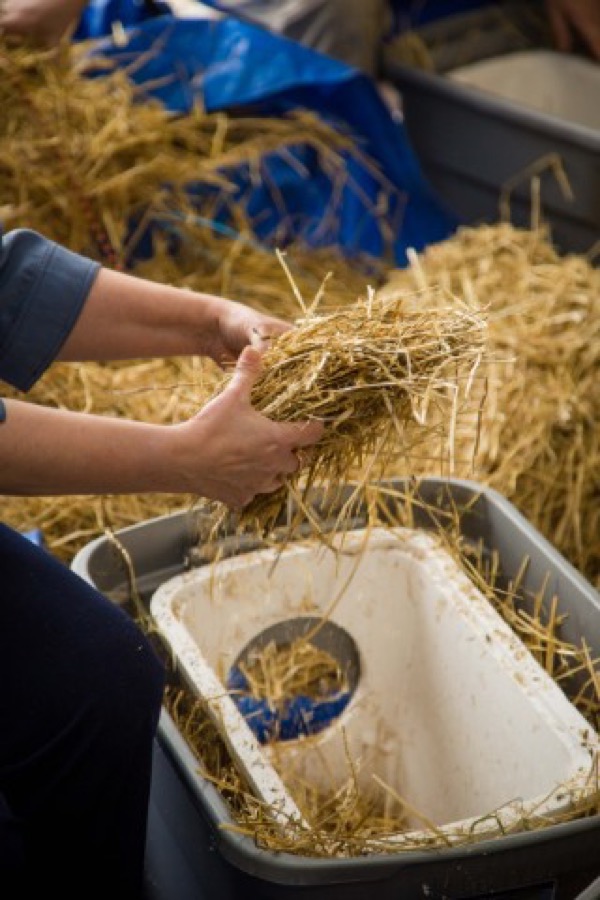
If you’re handy (or know someone who is handy) you can build your own shelter. There are also lots of options for pre-made shelters that you can purchase.
Visit Neighborhood Cats for several BUILD YOUR OWN OR PRE-MADE SHELTER options.
The ASPCA provides information on making a simple and inexpensive winter shelter from foam cooler bins. For more information and ASPCA winter shelter FAQs visit www.aspcapro.org/feral-cats/winter-shelter-bins.
Consider installing a cat door with a plastic flap in a shed or garage for a feral colony. Cat door kits can be purchased at discount stores, pet stores or hardware stores.
Rubbermaid Roughneck containers are a popular way to provide a safe and secure shelter for feral cats. Rubbermaid Roughneck is preferable because it is durable. A “Roughneck Home” is very effective and easy to make. Visit our SHELTERS PAGE for instructions and pictures of two easy versions of a Roughneck home.
FOOD AND WATER
Cats need extra calories in the winter months to maintain their energy levels so be sure to provide colony residents with extra rations.
Never feed and care for cats on property you do not own unless you have written permission. You are putting the cat’s life in the hands of the unknown. At any time you might be forced to move or “get rid” of the cats. Then what will become of the cats?
Never feed cats at night. This will encourage skunks, raccoons and other nocturnal animals to come for food. Only feed feral/free-roaming community cats during daylight hours.
Never throw food on the ground as this will encourage rodents to come to your feeding areas. Feeding stations and areas should be kept clean and neat. Do not leave dirty dishes lying around. Be a good neighbor and in return your free-roaming cats will be good neighbors.
Provide fresh food and water at a consistent time each day. Feral cats soon learn when the food arrives and will be waiting for a fresh supply of rations, even if they are hiding in nearby bushes.
Purchase several large plastic water bowls from pet stores or a discount store. Look for ones that have a wide base so they easily tip over. Fill a large soda bottle or water bottle with water and store on site so you always have water handy. Be sure to keep water clean at all times.
In summer months flies are attracted to canned food so offer limited amounts of canned food during the summer months. Also in the warmer months, keep the canned cat food separate from the dry food.
In the winter months, if you know your colony will eat right away, warm up the canned food prior to taking it to the feeding site and add a little warm water to the food for extra moisture. Always provide dry food because canned food will eventually freeze.
FEEDING STATIONS
A feeding station establishes a specific area where the cats know to come for food, so they spend as little time exposed to the elements as possible.
To protect food and water from the elements, place them in a covered shelter (feeding station). This will protect the cats as they eat or drink. There are many variations and types of feeding stations to put food and water in. They can be purchased pre-made or you can build your own.
A simple feeding station with a roof and sides will protect food and cats.
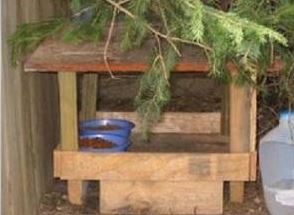
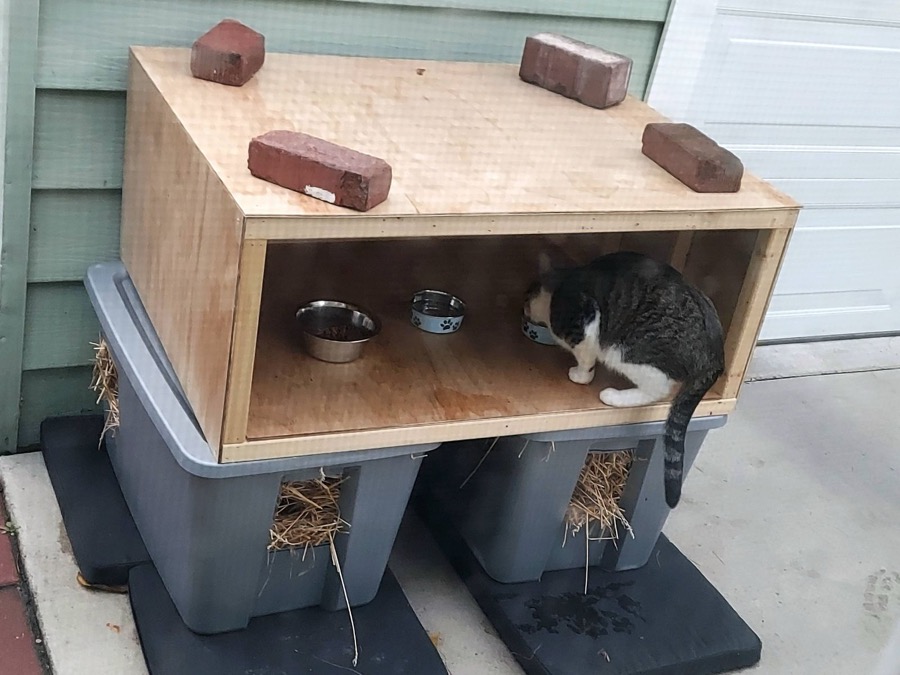
It’s important that one side of the feeding station be open because only a small opening or doorway could allow one cat to stay or sleep in there and keep the other cats out.
A stand with a sloping roof, open on two sides, and off the ground, may be all that is needed for several cats to eat together.
One of Feral Cat FOCUS’s favorite feeding stations is a Rubbermaid storage bin. It’s easy to clean because of the removable top and quick to put together. Small automatic feeders and waterers will fit inside.

Use a box-cutter to cut out most of one of the long sides, leaving a few inches off the ground to prevent flooding.
Having difficulty cutting the plastic? Try blowing hot air from a hairdryer on the area where you plan to cut. This softens the plastic and makes it easier to cut through.
When feeding in the summer, bugs can pose a problem.
To help keep bugs out of the food place a small heavy bowl in the middle of a slightly larger bowl. Partially fill the larger bowl with water. The bugs cannot get to the food because it is surrounded by water.
In the winter take hot water to the feeding stations. This helps keep water drinkable for a while before it freezes. If you have a feeding station near an electrical outlet, an electrically powered water bowl designed to keep the water at a temperature above freezing is an option. These are available at most pet supply stores and feed stores.
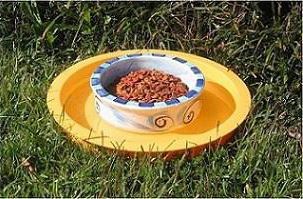
BE A GOOD NEIGHBOR WHEN CARING FOR CATS
It is common for conflicts to stem from issues between neighbors or people living in the same area as a feral cat colony. Try to resolve problems with neighbors immediately and don’t wait until problems only get worse. For the health of the cats and for good community relations:
- Get the cats spayed or neutered and vaccinated as soon as possible.
- Keep the feeding location neat and clean.
- Keep food dishes in one place to facilitate cleanup and to provide a tidy appearance.
- Remove feeding dishes within 30 minutes.
TAKE NECESSARY PRECAUTIONS TO AVOID BEING BITTEN OR SCRATCHED BY ANIMALS
Please take precautions to protect yourself and the animal. Rabies can be transmitted to humans when an infected animal bites/scratches a human. Rabies is fatal to humans, unless a series of post exposure vaccinations is received soon after a person has been exposed to rabies. If you are bitten or scratched by an animal that is not vaccinated seek immediate medical attention from a physician, confine the animal if possible, and report the incident to your County Health Department. An non-vaccinated animal that is exposed to a known or suspected rabid animal must be either sacrificed and properly disposed of or confined in a manner acceptable to the Health Department for six (6) months, at the expense of the owner.
